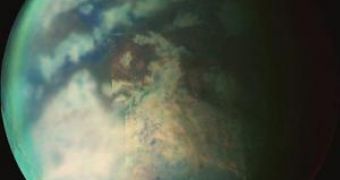Titan, Saturn's largest satellite, still holds some exciting surprises, as a new set of images from the European Space Agency show. Until very recently, this atmosphere inhibited understanding of Titan's surface, but the moon is currently undergoing study by the Cassini-Huygens mission and new information about it is accumulating.
Professor John Zarnecki of The Open University led the Surface Science Package (SSP) on Huygens "Huygens has provided us with a rich seam of data to mine -- and we shall be digging through it for some time to come. The Surface Science Package returned immediate information about Titan about the landing Huygens made but it is also a part of the longer term picture, piecing together the whole environment on Titan."
The newest combined images of the transmitted data and computer models help astronomers worldwide to visualize Titan as a working world. "Even though we have only four hours of data, it is so rich that after two years of work we have yet to retrieve all the information it contains," says Fran?ois Raulin, Huygens Interdisciplinary Scientist, at the Laboratoire de Physique et Chimie de l'Environnement, Paris.
The Huygens probe reached Saturn's moon Titan on January 14, 2005, where it made an atmospheric descent to the surface and still relays scientific information, two and a half years after the historic landing.
Some of the most recent data show that the atmosphere was hazier than expected because of the presence of dust particles, called 'aerosols'. Now, scientists are learning how to interpret their analysis of these aerosols, thanks to a special chamber that simulates Titan's atmosphere.
After getting as close as 40 kilometers to Titan's surface, the cameras on the probe took their first distinct images of the surface, showing an incredible landscape and proving that a liquid, possibly methane flowed on the surface, causing erosion. Sensors on the probe also analyzed atmospheric data to create a new model of the blurry atmosphere, based on the winds, which reveals that Titan's atmosphere is a giant conveyor belt, circulating its gas from the South Pole to the North Pole and back again.
One of the satellite's curiosities is a strange radio signal emitted at an extremely low frequency. So far, no one was able to pinpoint the origin and what causes this signal, since the only other world on which ELF waves were detected before was Earth.
The Cassini-Huygens mission will continue to do its duty of determining the time variability of Titan's clouds and hazes and to characterize Titan's surface on a regional scale, at least until 2008, when it will be decommissioned.

 14 DAY TRIAL //
14 DAY TRIAL //